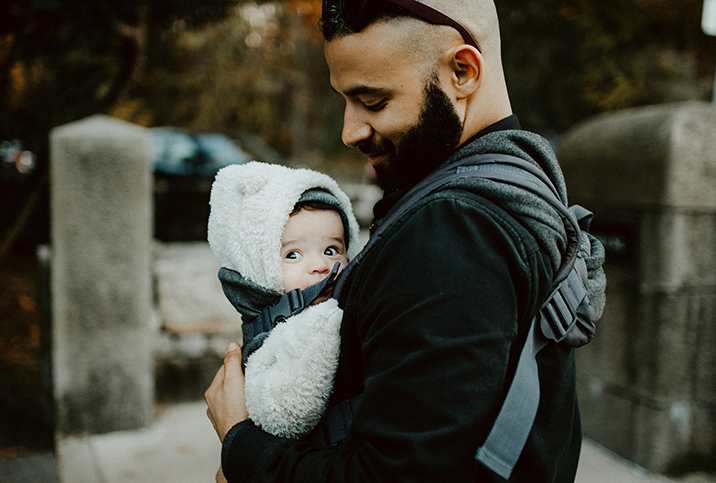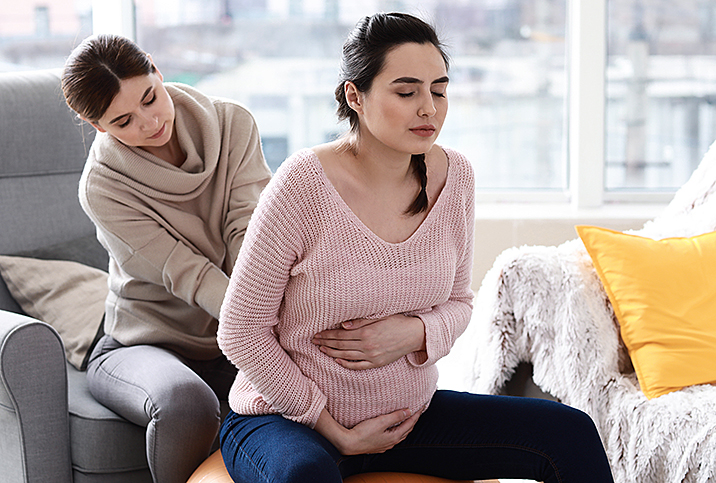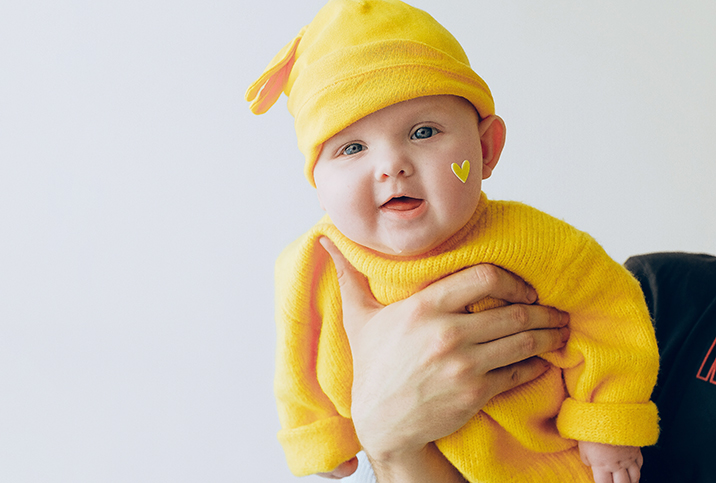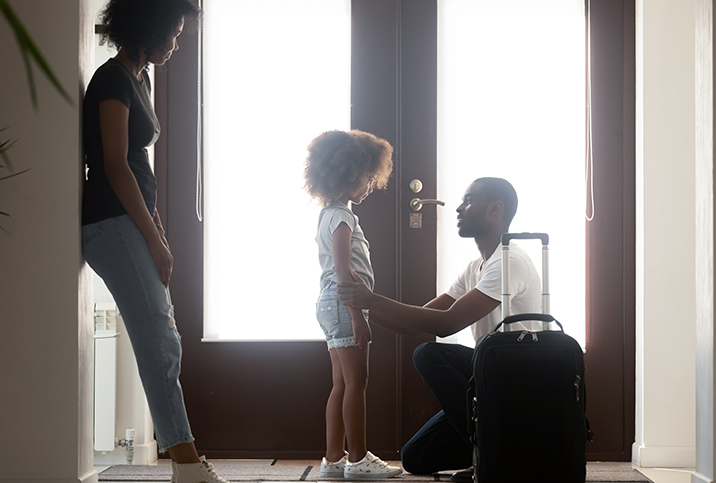Baby-Wearing: The Benefits, Drawbacks and How to Do It Safely

Let's face it—most parents, by the nature of modern society and the natural roles of mom and dad, are multitaskers. Very few have the luxury of focusing 100 percent on their littlest one while running around after a toddler, managing work and home life, and, you know, allowing a little space for self-care. This makes baby-wearing devices incredibly helpful for the on-the-go parent who wants to keep their baby close while still managing other tasks.
That said, baby-wearing isn't for every parent (or every baby), and with the different types of devices on the market, not every device is for every parent (or baby). So, before you stock up on ring slings in 12 different colors and patterns, consider these tips to enter the world of baby-wearing with confidence.
The benefits of baby-wearing
When your baby is sleeping it's easy to put him in his crib or bassinet and let him sleep while you're doing other things. But when your baby is awake? It's a different story. Most little ones love to be held and cuddled, or want to enjoy attention from mom and dad. And as much as you love snuggling with your sweet baby, it can make it hard to do other things…especially if you have other kids to care for.
Mary Sauer, a mom of four and a parenting writer for Truly Mama and What To Expect, found that baby-wearing was a lifesaver when trying to juggle the needs of an infant, toddler and older siblings.
"It enables parents to keep going when their baby is teething and crabby and needs the comfort that closeness provides," she explained. "Feeling torn in all directions is so discouraging, and a carrier is a lifesaver when the demands of parenting start to feel like too much."
And Sauer, like many parents, found that baby-wear was particularly helpful when trying to juggle responsibilities as a work-from-home mom. She would stand at her counter, wearing her napping toddler on her back as she typed on her computer.
"I've worked at home for a long time, and I haven't always had childcare to fall back on. I don't know how I would have survived those difficult days without my baby carrier!" she said.
So, if you're looking for the freedom to move around, work, clean your house and care for other children while keeping your little one close, baby-wearing might be a good fit. Particularly if your child craves the closeness and security she feels when held tight against your body.
The drawbacks of baby-wearing
One thing to keep in mind is that not every baby responds positively to sitting in a carrier. Some may find it too restrictive, uncomfortable or hot. And if you happen to have a baby who's not a fan of the carrier, he won't shy away from letting you know.
If your baby starts to fuss as soon as you place her in the carrier, it may be a sign to try a different style of device or to wait a week or two before trying again. Sometimes it just takes a few attempts for your little one to settle in.
Of course, it's not just your baby who might decide a carrier isn't a good fit. Many parents find holding their babies so close to their bodies is unbearably hot. Or in some cases, it's simply uncomfortable or feels too heavy.
In these cases, you may benefit from using a different style of carrier (for instance, opting for one with a more breathable, lighter-weight fabric if it feels too uncomfortable or heavy. Also, short stints using the carrier (starting with 15 to 30 minutes per day) may help you build the strength you need through your core, shoulders and upper back to be able to carry your baby for longer periods.
There are also a few practical drawbacks. It's hard to bend over when you have your baby on your body. If you drop something that needs to be picked up, this can be an issue. Likewise, if you're trying to put dishes in a lower dishwasher rack, or you're using your baby-wearing time to pick up the house.
That said, you can maximize this opportunity and use it as a chance to add a few more squats or lunges to your routine—squatting rather than bending over is a great way to strengthen your lower body, protect your back and keep your baby safe, all at the same time.
Baby-wearing is safe when done correctly
Generally speaking, keeping your infant or young toddler strapped to your body is an incredibly safe choice—the baby is right there at your chest (or your back), giving you the ability to keep a close eye while having your hands free. But there are things you should keep in mind to keep your baby safe.
Know the acronym 'TICKS'
Safe sleep advocate and San Francisco-based mom Lauren Levy points to TICKS as a helpful way to remember the key safety protocols for baby-wearing:
- Tight: The straps to your device or sling should be snug and tight, with your baby held close. This protects the parent's back and ensures the baby is upright enough to breathe comfortably.
- In view at all times: You should be able to see your baby's face (not just the top of his head) whenever you glance down. She shouldn't be "tucked in" or when cradled, turned toward your chest, which could interfere with breathing.
- Close enough to kiss: Your baby shouldn't be sitting low on your body. Rather, his head should be as close to your chin as possible, enabling you to kiss the top of his head if you tilt your chin down.
- Keep chin off the chest: You don't want your baby to be "curled up," where her chin touches her chest, which could restrict breathing. Double-check your baby's head position and make sure there's at least a finger's-width distance between her chin and chest.
- Supported back: This is important for both of you! You don't want your baby's added weight to pull on your upper back or shoulders and cause pain. But it's also important to make sure the baby's back is well-supported within the device so he's not slumped in a way that might restrict breathing.
Transfer a sleeping baby
Levy also emphasized that while it's perfectly fine for a baby to fall asleep while being held in a device, it's always best to transfer a sleeping baby to a safe sleep space. Safe sleep spaces (cribs or bassinets) allow your baby to sleep comfortably on her back without the added risk of a breathing restriction due to body position.
Don't run, jump or cook while baby-wearing
Sauer stated that just because your hands are free while baby-wearing doesn't mean you're free to do every activity. "Anything you wouldn't do while holding your baby you shouldn't do while wearing your baby," she said.
Young infants still need head support
Sauer also made it clear that if your baby's head still needs support when carrying him, you should maintain that support while baby-wearing. "Parents must support their head with a hand at all times, and keep their activity gentle enough for a newborn," she explained.
Read the instructions and practice, practice, practice
Weight-ratings, sizes and how to secure and use baby-wearing devices vary from brand-to-brand and style-to-style. It's incredibly important that you read the instructions that come with your device to make sure you're adhering to its safety guidelines.
For instance, one sling might be rated to 30 pounds, while another is rated to 35. If your baby falls into that 31 to 35 pound increment difference, and you're not aware of the problem, you could inadvertently be increasing the risk of an accident or issue.
Plus, as Sauer said, some styles of baby-wearing device are easier to mess up than others. "Tied wraps, like a Solly Baby or a woven wrap are wonderful, but there's definitely a learning curve," she explained. That's why, regardless of the style of wrap or device you choose, you need to practice to get the most secure and safe positioning.
Common baby-wearing devices
If you're ready to dive into baby-wearing, it's important to be generally aware of the devices on the market. These are the major types available, along with their pros and cons:
Ring slings
Ring slings are worn like a cross-body bag, secured over one shoulder with a cradle-like "pocket" for your baby at your abdomen. These are excellent for infants, as they can allow you to breastfeed while baby-wearing. Plus, they offer a lightweight, breathable option for parents.
That said, carrying almost all of the weight of the device on one shoulder can be uncomfortable, and even painful. It's important to switch which shoulder is carrying the weight of the baby with each use to avoid the potential for upper back or shoulder pain.
Soft wraps
This style of wrap is simply a large piece of lightweight, breathable fabric that can be wrapped around your body in different ways before securing it in place. This makes it great for hot-weather environments, and it's a good way to try baby-wearing without using a heavy device.
However, due to the often-stretchy consistency of the fabric, it's best suited for infants or smaller babies. Also, getting the wrap right may take a few attempts. The last thing you want is to drop your baby, so practice with a bag of sugar or a baby-sized doll before putting your real baby inside.
Woven wraps
Woven wraps are more-or-less the same as soft wraps (with the same general benefits and drawbacks), but the fabric material is stiffer and capable of carrying more weight. So, if you like the soft wrap with your infant, you may want to "graduate" to a woven wrap as your baby puts on more weight.
Meh dai carriers
This type of carrier is a bit like a premade wrap in that the material is often lightweight and somewhat stretchy, although the carriers are more structured (and often offer a back support) for your baby. They involve a strap that wraps around each shoulder and the hips. This allows you to carry your baby on your front, at your hip or on your back.
They're appropriate for infants or small toddlers, but because they don't offer quite as much structure or support as a soft-structured carrier, they may be uncomfortable for heavier or larger children.
Soft-structured carriers
A soft-structured carrier is more structured and supportive, generally bulkier and heavier and usually made to carry more weight. This makes them appropriate for larger babies and toddlers, as well as longer wearing-time as the structure and support can make it more comfortable to wear your baby.
They can, however, be hot and too heavy for newbie baby-wearers, so they may be more appropriate for men, taller or stronger women, or those who have been baby-wearing for a while.
Give it a try
At the end of the day, when it comes to life as a parent, it's all about finding what works best for you and your baby. Baby-wearing can offer great benefits for parents and babies, but it's okay if you simply don't enjoy it.
Test-drive different devices before laying out a lot of cash, and see if there's a style that feels comfortable and safe. Even if you only baby-wear from time to time, having the option may give you added flexibility that makes your life a little easier to manage.

















